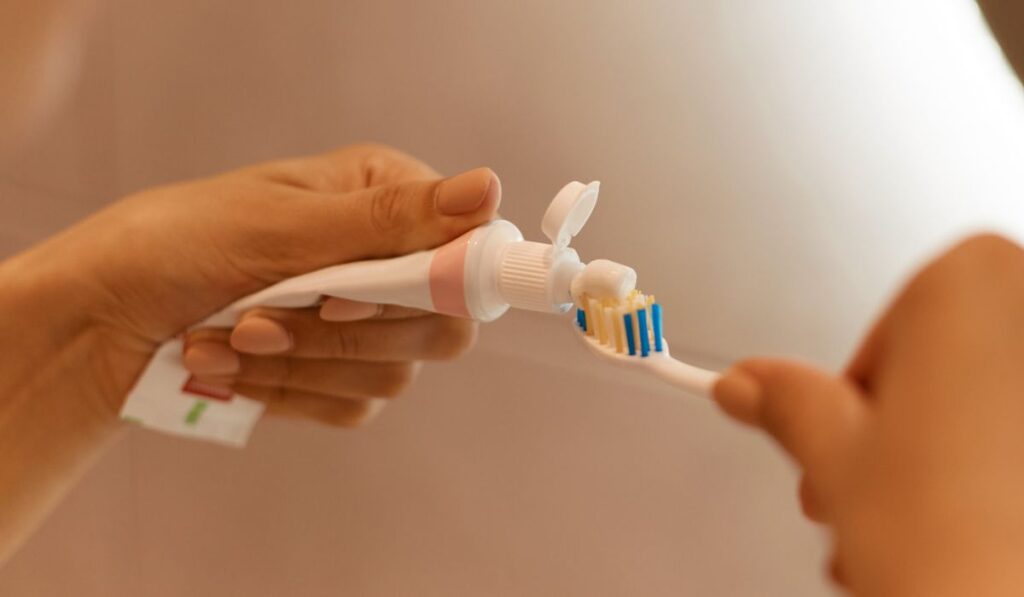The world is quickly changing, with many people shifting to an eco-friendly lifestyle. Therefore, it has become mandatory to get rid of waste, especially daily life products like toothpaste, in a more environmentally conscious manner. So, is toothpaste recyclable?
Toothpaste itself isn’t recyclable because of its ingredients, such as Brilliant Blue FCF and Helidon Pink, which are poisonous to the environment. Toothpaste tubes, caps, and toothbrushes are typically recyclable, though.
Let’s look at the recycling process of toothpaste tubes and toothbrushes in detail and check out a few biodegradable kinds of toothpaste you can use to ensure you’re always protecting the environment.
Is Toothpaste Recyclable?

Toothpaste isn’t recyclable due to some of its ingredients, but its packaging can be recycled. To find out if your toothpaste tube is recyclable, check if it has the recycling symbol or contact your local recycler to see whether they can process toothpaste tubes before throwing them into your curbside bin.
Alternatively, you could send the toothpaste tubes to a recycling company like TerraCycle, which specializes in recycling hard-to-recycle materials. TerraCycle offers a free Oral Care Recycling Program to help us dispose of our oral care products better.
You just need to fill a box with toothpaste tubes, caps, toothbrushes, and floss containers, then mail it back to TerraCycle for recycling. Each valid shipment upwards of five pounds earns you TerraCycle points that you can redeem for cash donations to your favorite non-profit organization, school, or charity.
Here’s a brief overview of how the recycling process works.
Recycling the Tube
First, you’ll need to squeeze out as much toothpaste from the tube as possible. Don’t slit open the toothpaste tube to remove the leftover toothpaste. Instead, close the cap and put the tube in your recycling bin.
The cap is recyclable, so it would be best to put it back on the tube before throwing it in the recycling bin to avoid littering. However, since the cap is made of a distinct plastic from the tube, some recyclers might fancy that you remove the cap before recycling the tube. You’ll have to confirm your local recycling regulations to be sure.
At the recycling facility, the tube with the sticky toothpaste residue is shredded to get the residuals out of the tube. Shredding exposes the inner surface of the tube with the residuals, which makes cleaning them more manageable.
The shredded toothpaste tube is then passed through a thorough washing cycle where the tiny pieces are cleaned with water or a biocide. This chemical substance dissolves bio-based materials.
After the cleaning process, it gets sent to a Material Recovery Facility (MRF) for sorting. It’s then sent to a reprocessor who converts HDPE into small plastic pellets. These pellets can eventually be remade into new products.
Identical shredding and pelletizing procedures are used to recover and recycle other oral care products with plastic packagings, such as mouthwash containers and dental floss packaging.
Recycling Toothpaste
While some toothpaste ingredients like cellulose gum are harmless to the environment, other substances like Brilliant Blue FCF are dangerous. These compounds make recycling toothpaste practically impossible and unfriendly to the environment.
Brillant Blue FCF
Brilliant Blue FCF is a colorant that makes your toothpaste appear blue. It’s commonly used in Colgate toothpaste and other food, cosmetics, and pharmaceuticals.
This ingredient is a threat because it’s destructive to marine life. Brilliant Blue FCF can stay in the water even after it passes through sewage systems. A little bit of toothpaste is harmless. However, when many people use it, its effects on marine life can be catastrophic.
Helidon Pink
Another toothpaste ingredient known to be toxic to marine life is Helidon Pink. Like Brilliant Blue FCF, it’s a colorant in toothpastes, including Aquafresh.
Helidon Pink isn’t only harmful in the water but also in the soil. It can remain in the soil for almost a year before it entirely degrades, which means that this poisonous substance stays present in the soil as more of it keeps getting added through poor dumping of waste.
Sodium Pyrophosphate
The most extreme toothpaste ingredient of them all is sodium pyrophosphate. It contains phosphor, which supports algae growth in sewage systems and the water at the tip of the sewage line.
Accumulation of algae escalates the amount of CO2 being released into the water, forming a dead spot. Consequently, all fish and other aquatic animals in that area will gradually suffocate and die.
Are Toothbrushes Recyclable?

Toothbrushes are recyclable, but the process is complicated because they are made up of three components- the nylon bristles, the metal staple holding the bristles in place, and the plastic handle- which need to be separated before recycling them.
Once the three components are separated, the metal staple is processed through regular recycling. On the other hand, the nylon bristles and plastic handle are shredded, cleaned, pelletized, and later used in manufacturing items like picnic tables, bike racks, and benches, among other items.
Biodegradable Toothpaste
Switching from your regular toothpaste to biodegradable toothpaste is a great and effective way of protecting the environment. The following are popular eco-friendly toothpaste options:
Tom’s of Maine
Tom’s of Maine toothpaste (on Amazon) has no artificial sweeteners, flavors, colors, or preservatives, and you can find it in most stores. It boasts incredible whitening and anticavity effects and has an official ADA seal of acceptance. It has no artificial sweeteners, flavors, colors, or preservatives.
Hello Oral
Hello Oral Sensitive Relief Fluoride toothpaste (on Amazon) uses aloe vera and potassium nitrate to alleviate sensitive teeth.
Dr. Bronner’s
It’s a well-liked and widely available brand that manufactures biodegradable soaps and cleaning products. In addition, Dr. Bronner’s toothpaste (on Amazon) is natural, vegan, fluoride-free, and cruelty-free, and its packaging is recyclable. It also uses 70% organic ingredients and is available in three flavors (cinnamon, anise, and peppermint).
Jason
Jason’s toothpaste (on Amazon) is fluoride-free and organic. Although many people have mentioned that its spiced cinnamon taste is awful, it still promises healthy teeth and gums.
Dr. Ken’s
Dr. Ken’s (on Amazon) maximum care toothpaste is anticavity, antigingivitis, antibacterial, antiplaque, antioxidant, and anti-tartar. It’s practically anti-everything! It also has a pleasant minty flavor. Its only downside is that it contains sodium fluoride.
Radius
Radius organic toothpaste (on Amazon) is made from chamomile and coconut oil. It comes in BPA-free packaging and is natural and cruelty-free. Numerous reports show it’s tasty and even has a coconut-banana flavor for children.
Nature’s Gate
Nature Gate whitening gel (on Amazon) has no artificial colors or sweeteners and is fluoride-free. However, its texture is almost similar to paste, and squeezing it out of the tube is difficult.
Kiss My Face
Kiss My Face whitening toothpaste (on Amazon) is organic and fluoride-free. Surprisingly, it contains Iceland moss as one of its ingredients. This probably makes it get an incredibly low review compared to other toothpastes. It also contains sodium lauryl sulfate (SLS), which the Environmental Working Group doesn’t recommend.
Desert Essence
Desert Essence (on Amazon) Natural Tree Oil Toothpaste has no artificial preservatives and sweeteners and is fluoride-free. It also has seaweed extract as one of its ingredients, and though some might find it to have a refreshing taste, others claim it’s a bit too salty.
DIY Toothpaste
You could also make your toothpaste using available natural ingredients in your home. This way, you’ll eliminate the harmful toothpaste ingredients and packaging entirely.
Simply mix coconut oil and baking soda at a 2:1 ratio, and then add drops of your preferred essential oil like peppermint.


